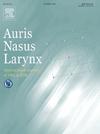Expiratory pressures generated by heat moisture exchangers in laryngectomized patients
IF 1.5
4区 医学
Q2 OTORHINOLARYNGOLOGY
引用次数: 0
Abstract
Objective
HMEs (Heat and Moisture Exchangers) are used postoperatively in laryngectomized patients to replace upper airway functions such as heating, humidification, filtration and resistance that are lost by the surgery. The clinical value of HME resistance function is controversial. There are no studies reporting actual measurements of air pressure generated by HMEs during breathing. In this paper we evaluated air pressures generated by HMEs (XtraFlowⓇ, XtraMoistⓇ, LifeGoⓇ, and LifeHomeⓇ. Atos Medical, Japan), compared the obtained data with theoretical pressure, and discussed the comparison with the expiratory pressure of pursed lips breathing reported in the past.
Methods
Nine patients who had laryngectomy were enrolled in this study. All participants were male, and the mean age was 72.3 ± 6.7. A pressure measurement system using a U-shaped water manometer was created to measure pressures generated by HMEs. Expiratory pressures were measured in all HMEs at rest and in XtraFlowⓇ and LifeGoⓇ during light exercise.
Results
Peak expiratory pressure was 5.67 mmH2O (95 %CI, 3.24 to 8.11) and time averaged expiratory pressure was 3.00 mmH2O (95 %CI, 1.56 to 4.45). These pressures were consistent with theoretical values. The finer HME, the higher pressure. The coarse filters had lower expiratory pressure but did not exceed the pressure from the fine filters even with the added pressure from the treadmill load (3Mets).
Conclusion
Endotracheal pressure was approximately less than 10 mmH2O during expiration in Atos HMEs. The fine filters, such as XtraMoistⓇ and LifeHomeⓇ, had greater exhalation pressures than coarse filters such as XtraFlowⓇ and LifeGoⓇ. The pressure drops of HMEs seemed lower than the pressure drops added by pursed lips expiration and HMEs may not be a substitute for pursed lips expiration.
喉切除病人的热湿交换器产生的呼气压力
目的:在喉切除术患者术后应用hmes (Heat and Moisture exchanges)替代因手术丧失的上呼吸道加热、湿化、过滤、阻力等功能。HME耐药功能的临床价值存在争议。没有研究报告在呼吸过程中由HMEs产生的气压的实际测量结果。在本文中,我们评估了HMEs (XtraFlowⓇ,XtraMoistⓇ,LifeGoⓇ和LifeHomeⓇ)产生的空气压力。Atos Medical, Japan),将获得的数据与理论压力进行了比较,并讨论了与过去报道的闭口呼吸的呼气压力的比较。方法纳入9例喉切除术患者。所有参与者均为男性,平均年龄为72.3±6.7岁。设计了一种u形水压计压力测量系统,用于测量HMEs产生的压力。在休息时测量所有HMEs的呼气压,在轻度运动时使用XtraFlowⓇ和LifeGoⓇ测量呼气压。结果呼气压力为5.67 mmH2O (95% CI, 3.24 ~ 8.11),时间平均呼气压力为3.00 mmH2O (95% CI, 1.56 ~ 4.45)。这些压力与理论值一致。HME越细,压力越高。粗过滤器的呼气压力较低,但即使在跑步机负荷增加压力的情况下,也不会超过细过滤器的压力(3Mets)。结论Atos HMEs呼气时气管内压力约小于10 mmH2O。精细过滤器(如XtraMoistⓇ和LifeHomeⓇ)比粗过滤器(如XtraFlowⓇ和LifeGoⓇ)具有更大的呼气压力。HMEs的压力降似乎低于闭口呼气增加的压力降,HMEs可能不能替代闭口呼气。
本文章由计算机程序翻译,如有差异,请以英文原文为准。
求助全文
约1分钟内获得全文
求助全文
来源期刊

Auris Nasus Larynx
医学-耳鼻喉科学
CiteScore
3.40
自引率
5.90%
发文量
169
审稿时长
30 days
期刊介绍:
The international journal Auris Nasus Larynx provides the opportunity for rapid, carefully reviewed publications concerning the fundamental and clinical aspects of otorhinolaryngology and related fields. This includes otology, neurotology, bronchoesophagology, laryngology, rhinology, allergology, head and neck medicine and oncologic surgery, maxillofacial and plastic surgery, audiology, speech science.
Original papers, short communications and original case reports can be submitted. Reviews on recent developments are invited regularly and Letters to the Editor commenting on papers or any aspect of Auris Nasus Larynx are welcomed.
Founded in 1973 and previously published by the Society for Promotion of International Otorhinolaryngology, the journal is now the official English-language journal of the Oto-Rhino-Laryngological Society of Japan, Inc. The aim of its new international Editorial Board is to make Auris Nasus Larynx an international forum for high quality research and clinical sciences.
 求助内容:
求助内容: 应助结果提醒方式:
应助结果提醒方式:


